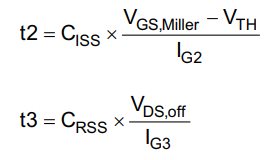Hi,
The question is the same as the last question of the related thread.
I heard that Rise/Fall time is calculated by the following equation according to the following document and the calculator uses the gate charges of the MOSFET as these a common values in the datasheet and the gate drive voltage of the MOSFET is know. .
https://www.ti.com/lit/ml/slua618a/slua618a.pdf

Could you tell me the actual values?
CISS:
CRSS
VDS, OFF
I would like to verify the calculation.
Best Regards,
Kuramochi



